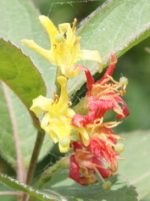 Bush honeysuckle is a small deciduous suckering shrub native to open deciduous or mixed coniferous woods, rocky slopes, and roadsides in eastern North America from Newfoundland to Saskatchewan, south to the mountains of Georgia and Alabama. It is a member of the honeysuckle family, Caprifoliaceae, that also includes snowberry, Abelia, and valerians. Dense branches carry glossy oval leaves that are two to five inches and have finely toothed margins. The leaves are tinged with bronze when they emerge in the spring but become deep green before turning clear yellow to apricot or scarlet in autumn. Beginning in late spring fragrant yellow-orange, tube- like flowers ½” across appear in panicles and are attractive to hummingbirds and butterflies. They give rise to dry woody capsules that attract song birds. Bush honeysuckle is a good choice for a low screen, small hedge, a woodland garden or for erosion control. The generic name, Dierville, honors the French surgeon, Dierville, who introduced the plant to France in the 18th century. The specific epithet, lonicera, is the generic name of true honeysuckles, and refers to the similarity of the flowers.
Bush honeysuckle is a small deciduous suckering shrub native to open deciduous or mixed coniferous woods, rocky slopes, and roadsides in eastern North America from Newfoundland to Saskatchewan, south to the mountains of Georgia and Alabama. It is a member of the honeysuckle family, Caprifoliaceae, that also includes snowberry, Abelia, and valerians. Dense branches carry glossy oval leaves that are two to five inches and have finely toothed margins. The leaves are tinged with bronze when they emerge in the spring but become deep green before turning clear yellow to apricot or scarlet in autumn. Beginning in late spring fragrant yellow-orange, tube- like flowers ½” across appear in panicles and are attractive to hummingbirds and butterflies. They give rise to dry woody capsules that attract song birds. Bush honeysuckle is a good choice for a low screen, small hedge, a woodland garden or for erosion control. The generic name, Dierville, honors the French surgeon, Dierville, who introduced the plant to France in the 18th century. The specific epithet, lonicera, is the generic name of true honeysuckles, and refers to the similarity of the flowers.
Type: Deciduous shrub
Outstanding Feature: Flowers
Form: Arching, vase-like
Growth Rate: Rapid
Bloom: Fragrant yellow-orange, tube- like flowers ½” across appear in panicles from late spring into summer
Size: 2-3’ H x 2-4’ W
Light: Full sun to part shade
Soil: Average, medium moist, well-drained, slightly acidic; drought tolerant
Hardiness: Zones 3-7
Care: Low maintenance
Pests and Diseases: None of significance but susceptible to leaf spot and powdery mildew.
Propagation: Seed, transplanting suckers, semi-hardwood and softwood cuttings